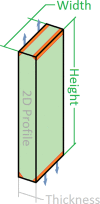Development of Standardized Material Testing Protocols for Prosthetic Liners
- PMID: 28233885
- PMCID: PMC5444209
- DOI: 10.1115/1.4035917
Development of Standardized Material Testing Protocols for Prosthetic Liners
Abstract
A set of protocols was created to characterize prosthetic liners across six clinically relevant material properties. Properties included compressive elasticity, shear elasticity, tensile elasticity, volumetric elasticity, coefficient of friction (CoF), and thermal conductivity. Eighteen prosthetic liners representing the diverse range of commercial products were evaluated to create test procedures that maximized repeatability, minimized error, and provided clinically meaningful results. Shear and tensile elasticity test designs were augmented with finite element analysis (FEA) to optimize specimen geometries. Results showed that because of the wide range of available liner products, the compressive elasticity and tensile elasticity tests required two test maxima; samples were tested until they met either a strain-based or a stress-based maximum, whichever was reached first. The shear and tensile elasticity tests required that no cyclic conditioning be conducted because of limited endurance of the mounting adhesive with some liner materials. The coefficient of friction test was based on dynamic coefficient of friction, as it proved to be a more reliable measurement than static coefficient of friction. The volumetric elasticity test required that air be released beneath samples in the test chamber before testing. The thermal conductivity test best reflected the clinical environment when thermal grease was omitted and when liner samples were placed under pressure consistent with load bearing conditions. The developed procedures provide a standardized approach for evaluating liner products in the prosthetics industry. Test results can be used to improve clinical selection of liners for individual patients and guide development of new liner products.
Figures











Similar articles
-
Testing of elastomeric liners used in limb prosthetics: classification of 15 products by mechanical performance.J Rehabil Res Dev. 2004 Mar;41(2):175-86. doi: 10.1682/jrrd.2004.02.0175. J Rehabil Res Dev. 2004. PMID: 15558371
-
Effect of thermocycling on bond strength and elasticity of 4 long-term soft denture liners.J Prosthet Dent. 2002 Nov;88(5):516-21. doi: 10.1067/mpr.2002.128953. J Prosthet Dent. 2002. PMID: 12474002
-
Effect of storage duration on the hardness and tensile bond strength of silicone- and acrylic resin-based resilient denture liners to a processed denture base acrylic resin.J Prosthet Dent. 2008 Feb;99(2):153-9. doi: 10.1016/S0022-3913(08)60032-3. J Prosthet Dent. 2008. PMID: 18262017
-
Compression and tension behavior of the prosthetic foam materials polyurethane, EVA, Pelite™ and a combination of polyurethane and EVA: a preliminary study.Biomed Tech (Berl). 2020 Dec 9;66(3):317-322. doi: 10.1515/bmt-2019-0110. Print 2021 Jun 25. Biomed Tech (Berl). 2020. PMID: 34062632
-
The slippery slope: critical perspectives on in vitro research methodologies.Dent Mater. 2012 Jan;28(1):41-51. doi: 10.1016/j.dental.2011.09.001. Dent Mater. 2012. PMID: 22192250 Review.
Cited by
-
Characterization of Prosthetic Liner Products for People with Transtibial Amputation.J Prosthet Orthot. 2018 Oct;30(4):187-199. doi: 10.1097/JPO.0000000000000205. J Prosthet Orthot. 2018. PMID: 30906148 Free PMC article. No abstract available.
-
Design of a Single Layer Metamaterial for Pressure Offloading of Transtibial Amputees.J Biomech Eng. 2021 May 1;143(5):051001. doi: 10.1115/1.4049887. J Biomech Eng. 2021. PMID: 33493283 Free PMC article.
-
Developing an Analogue Residual Limb for Comparative DVC Analysis of Transtibial Prosthetic Socket Designs.Materials (Basel). 2020 Sep 7;13(18):3955. doi: 10.3390/ma13183955. Materials (Basel). 2020. PMID: 32906701 Free PMC article.
-
Development of a magnetic composite material for measurement of residual limb displacements in prosthetic sockets.J Rehabil Assist Technol Eng. 2018 Apr 3;5:2055668318763481. doi: 10.1177/2055668318763481. eCollection 2018 Jan-Dec. J Rehabil Assist Technol Eng. 2018. PMID: 31191930 Free PMC article.
-
A finite element model to assess transtibial prosthetic sockets with elastomeric liners.Med Biol Eng Comput. 2018 Jul;56(7):1227-1240. doi: 10.1007/s11517-017-1758-z. Epub 2017 Dec 13. Med Biol Eng Comput. 2018. PMID: 29235055 Free PMC article.
References
MeSH terms
Grants and funding
LinkOut - more resources
Full Text Sources
Other Literature Sources
Miscellaneous

